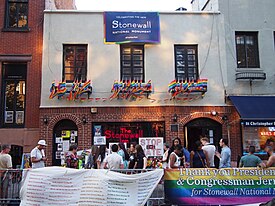LGBT culture in New York City
| LGBT culture in New York City | |

The Stonewall Inn in the gay village of Greenwich Village, Manhattan, the cradle of the modern gay rights movement.
|
|
|
||||||||||||||||||||||||||
New York City has one of the largest and most prominent LGBT populations in the world. Brian Silverman, the author of Frommer's New York City from $90 a Day, wrote the city has "one of the world's largest, loudest, and most powerful" LGBT communities" and "Gay and lesbian culture is as much a part of New York's basic identity as yellow cabs, high-rises, and Broadway theater." LGBT Americans in New York City constitute by significant margins the largest self-identifying lesbian, gay, bisexual and transgender communities in the United States, and the 1969 Stonewall Riots in Greenwich Village are widely considered to be the genesis of the modern gay rights movement. As of 2005, New York City was home to an estimated 272,493 self-identifying gay and bisexual individuals. The New York City metropolitan area had an estimated 568,903 self-identifying GLB residents. Meanwhile, New York City is also home to the largest transgender population in the United States, estimated at 25,000 in 2016.
Charles Kaiser, author of The Gay Metropolis: The Landmark History of Gay Life in America, wrote that in the era after World War II, "New York City became the literal gay metropolis for hundreds of thousands of immigrants from within and without the United States: the place they chose to learn how to live openly, honestly and without shame."
The Stonewall Inn, located at 51 and 53 Christopher Street, along with several other establishments in the city, was owned by the Genovese crime family. In 1966, three members of the Mafia invested $3,500 to turn the Stonewall Inn into a gay bar, after it had been a restaurant and a nightclub for heterosexuals. Once a week a police officer would collect envelopes of cash as a payoff; the Stonewall Inn had no liquor license. It had no running water behind the bar—used glasses were run through tubs of water and immediately reused. There were no fire exits, and the toilets overran consistently. Though the bar was not used for prostitution, drug sales and other "cash transactions" took place. It was the only bar for gay men in New York City where dancing was allowed; dancing was its main draw since its re-opening as a gay club.
...
Wikipedia

























